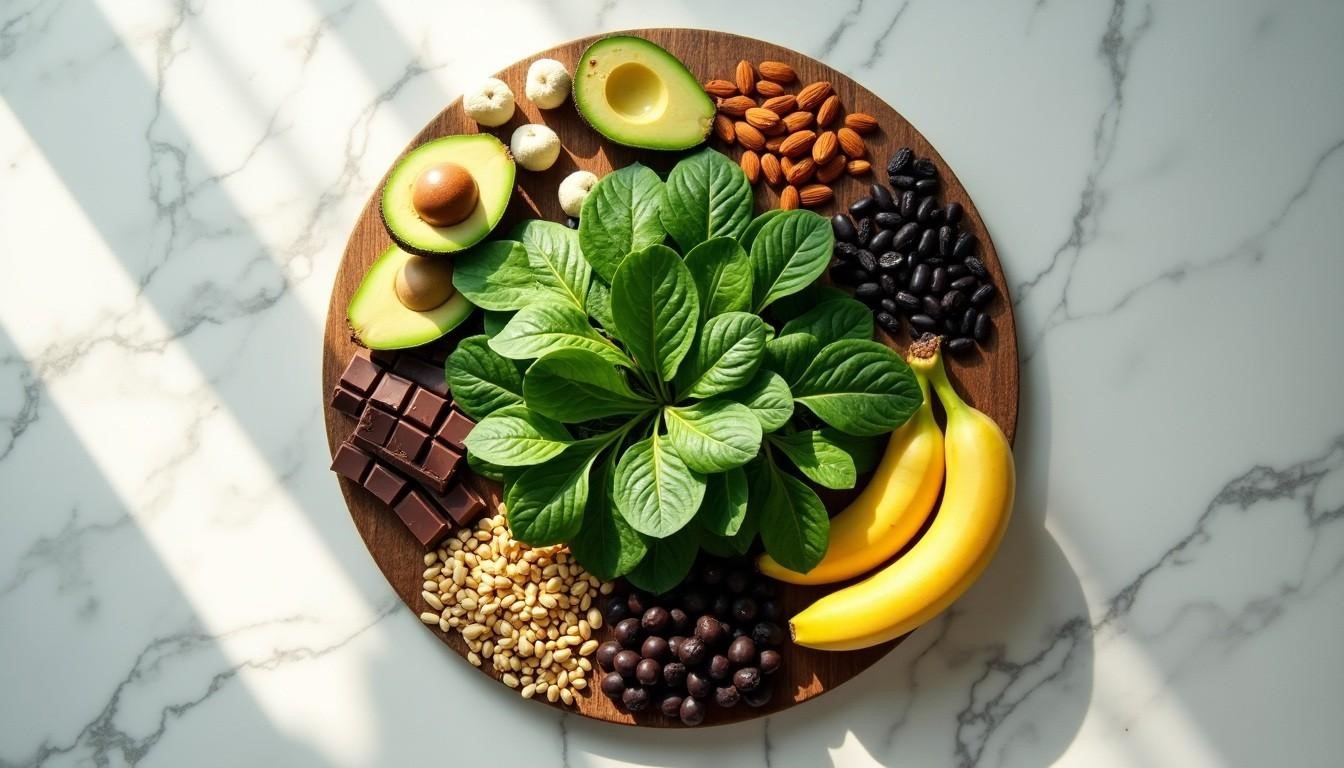

Magnesium plays a significant role in over 300 biochemical reactions throughout your body. These reactions help maintain heart rhythm and control blood pressure. Research shows that almost 50% of people don’t get enough of this vital mineral in their daily diet. Experts now call this shortage a “modern-day silent epidemic” of magnesium deficiency.
The UK’s recommended daily intake varies between genders. Women need 300 mg while men require 400 mg. Nature offers many magnesium-rich foods that help meet these requirements. Pumpkin seeds pack 168 mg per ounce, and cooked spinach provides 78 mg per half-cup. These delicious options make it easy to boost your magnesium intake through regular meals.
This piece explores the best dietary sources of magnesium and shows you the quickest ways to cook and add these nutritious foods to your daily meals.
Your body contains about 25 grammes of magnesium, making it the fourth most abundant mineral [1]. Half of this vital mineral lives in your bones. The rest spreads through soft tissues and body fluids [1].
This mineral helps power more than 600 enzyme reactions in your body [1]. Magnesium helps you:
Your heart needs magnesium to stay healthy. The mineral works against calcium to control heart contractions. Calcium makes heart muscle cells contract when it enters them. Magnesium steps in to help these cells relax [2].
Magnesium teams up with calcium to build stronger bones. Your nerves need it to work right, and it supports your immune system [2]. The mineral also keeps your blood pressure in check and helps your muscles work normally [1].
Your body works hard to keep magnesium levels steady, but you can become deficient if you don’t get enough over time. Watch out for these early warning signs:
The symptoms get worse as magnesium levels drop. You might notice mood changes, irregular heartbeats, and muscle cramps [1]. Low magnesium can lead to several health problems:
Blood Sugar Management: Almost half of people with type 2 diabetes have low magnesium levels [1]. Your cells need this mineral to use insulin properly and control blood sugar [2].
Cardiovascular Health: People with the lowest magnesium levels have a higher chance of dying from heart disease [2]. A huge study of over a million people showed that getting 100 mg more magnesium each day cut stroke risk by 7% and heart failure risk by 22% [2].
Mental Health Effect: A study of 8,800 people found something interesting. Adults under 65 who got the least magnesium were 22% more likely to get depression[2]. This happens because magnesium helps your brain work right and keeps your mood stable.
Some people have a higher chance of running low on magnesium. This includes older adults, people with Crohn’s or celiac disease, and those with type 2 diabetes[4]. Heavy drinkers and people taking certain medicines like diuretics or proton pump inhibitors might lose more magnesium than usual [4].
Men need 400-420 mg daily, while women need 310-320 mg [1]. Getting enough magnesium can be tricky. Blood tests don’t always show the real picture because most of your magnesium stays in your tissues and bones [4].
Plant-based foods are rich sources of magnesium that help maintain optimal mineral levels. Nature’s magnesium powerhouses pack impressive nutritional benefits in foods of all types.
Dark leafy greens rank among the best dietary magnesium sources. Cooked spinach tops the list with 156 mg of magnesium per cup [5]. Raw spinach has magnesium too, but cooking helps your body absorb this vital mineral better [5]. Swiss chard comes next with 75 mg per half-cup serving [1].
Other vegetables add significant magnesium to your diet:
Seeds are the mineral champions of the plant kingdom. Pumpkin seeds shine as exceptional sources with 156 mg of magnesium per ounce [5]. You can sprinkle these versatile seeds on salads, toast, and homemade granolas [5].
Here’s the magnesium content in nuts per ounce:
Flaxseed and chia seeds pack impressive magnesium too. Chia seeds contain 111 mg of magnesium per ounce [5], plus healthy omega-3 fatty acids and fibre. Flaxseed gives you 40 mg per tablespoon [1]. Both make great additions to morning porridge or smoothies.
The legume family includes many magnesium-rich foods. Black beans lead with 120 mg per cup [1]. Edamame, young green soybeans, provides 50 mg per half-cup[1] and 6 grammes of protein at just 65 calories [1].
Here’s the magnesium content in other legumes per half-cup:
Soybeans come in various magnesium-rich forms. Firm tofu contains 146 mg per cup [6], and soy milk gives you 61 mg per cup [5]. Black beans stand out as a protein-rich option that provides magnesium and fibre while helping maintain steady blood sugar levels [1].
Some preparation methods boost these foods’ nutritional benefits. Cooking spinach helps magnesium absorption [5], and a potato’s skin holds valuable minerals [1]. These foods offer bonus nutrients too – pumpkin seeds give you manganese and copper [1], while chia seeds pack calcium and antioxidants [1].
Plant-based options help meet daily magnesium needs while providing other essential nutrients. You can boost your magnesium intake by mixing these foods into your daily meals. The wide variety makes it easy to reach the recommended daily intake through these nutrient-dense foods.
Plant-based and animal-based foods are great sources of magnesium. Let’s take a closer look at seafood and dairy products that help meet your daily magnesium needs.
Fatty fish pack an impressive amount of magnesium. Chinook salmon tops the list with 122 mg per 100 grammes [2]. Atlantic mackerel comes in second with 97 mg of magnesium per 100-gramme serving [2]. These fish give you magnesium plus other key nutrients.
Here’s how much magnesium different fish contain per 100 grammes:
Wild-caught fish typically have more magnesium than farm-raised ones [4]. This comes from their natural diet and mineral-rich waters. The fish’s age and maturity also affect its nutrient levels [4].
These fish species work well with other nutrients. The omega-3 fatty acids in fatty fish boost how well your body absorbs and uses magnesium [4]. A half-fillet of salmon (178 grammes) gives you 53 mg of magnesium and 39 grammes of quality protein [4]. Yellowfin tuna deserves a mention with 36 mg of magnesium per 100 grammes [7]. Canned white tuna provides 28 mg per 85-gramme serving [7]. These options are perfect when you need quick and easy ways to get more magnesium.
Dairy products add a good amount of magnesium to your diet. The content changes based on how they’re processed and their fat levels. Nonfat chocolate yoghurt leads the pack with 68 mg of magnesium per 170-gramme container [3].
High-fat milk (3.7%) contains 63.4 mg of magnesium per 473 ml serving [3]. Here’s what other dairy products offer:
Dairy’s lactose helps babies absorb magnesium better [10]. Milk products are among children’s main magnesium sources, giving them 10-30% of what they need daily [10].
Scientists have found that magnesium-enriched milk reduces bacterial growth and spoilage. It also helps your intestines absorb more magnesium [10]. This could lead to new dairy products that deliver magnesium more effectively.
Magnesium works with other nutrients in dairy products. It affects calcium levels both inside and outside cells [10]. Your body needs magnesium to activate vitamin D and make it work properly [10].
Getting plenty of magnesium through dairy and other foods helps prevent vitamin D deficiency [10]. Adding both fish and dairy to your meals is a great way to keep your optimal magnesium levels up while getting other helpful nutrients too.
The way you cook your food makes a big difference in keeping its magnesium content intact. You need the right cooking methods to retain this vital mineral while preparing healthy meals.
Your microwave can be surprisingly good at keeping magnesium levels high in food. Research shows microwaving food with just a little water keeps almost all minerals intact [5]. This works great with vegetables like spinach and carrots, keeping over 90% of their nutrients [11].
Steaming is another great option to preserve magnesium. This gentle method only loses about 9-15% of nutrients from vegetables like broccoli, spinach, and lettuce [11]. The process also keeps more phytochemicals and glucosinolates – compounds you’ll find plenty of in Brussels sprouts, cauliflower, and cabbage [11].
Roasting brings out natural flavours in vegetables while keeping essential nutrients. This dry-heat method keeps vitamin B1 and B2 levels stable along with minerals [11]. Roasted tomatoes actually gain more lycopene while their magnesium stays steady [11].
Quick sautéing with just a bit of oil works well too. Food loses fewer nutrients because it cooks fast and barely touches water [11]. If you’re cooking fish or meat, dry heat methods like oven-baking, broiling, or roasting give the best results [12].
Boiling can wash away magnesium quickly as minerals leak into cooking water [5]. You’ll lose even more nutrients if vegetables sit in lots of water for too long [5]. But don’t waste that cooking liquid – use it in soups or sauces to get those nutrients back [13].
Food processing can really affect magnesium levels. Making white flour strips away minerals from cereal grains. The process of making white bread cuts out about 90% of its magnesium [5].
Cooking food too long is another issue. Long cooking times can strip away minerals [13]. High temperatures and too much water make this even worse. Vacuum drying keeps more magnesium in foods than hot air drying [14]. This matters if you’re into food preservation.
To keep more magnesium in your food:
Some cooking methods might actually help release more minerals. Boiled spinach can give you easier access to calcium and iron [11]. This shows why it’s important to know how different foods react to different cooking methods.
You might get the best results by mixing cooking methods. Try steaming vegetables briefly before a quick sauté – this keeps nutrients while giving great texture and flavour. A short microwave followed by roasting can keep minerals while developing tasty flavour profiles.
Making magnesium-rich balanced meals doesn’t have to be complicated. A good plan and the right food combinations will help you meet the daily requirements of 400 to 420 milligrammes for adult men and 310 to 320 milligrammes for women [15].
Magnesium rich foods make a great start to your day. Steel-cut oats work really well as a breakfast base and give you 70 mg of magnesium per quarter cup [1]. You can boost the mineral content with these additions:
A breakfast that combines these elements adds about 150 mg of magnesium to your daily intake [1]. Greek yoghurt with a banana or fortified breakfast cereal works great too [7].
Your midday meal gives you plenty of chances to add magnesium-rich ingredients. A nutrient-packed lunch might include:
This light but filling combo gives you roughly 100 mg of magnesium [1]. Edamame makes another great addition – half a cup provides 50 mg of magnesium and 6 grammes of protein at just 65 calories [16].
Dinner time lets you get creative with magnesium-rich ingredients. A balanced dinner could include:
This mix delivers about 200 mg of magnesium [1]. Quinoa paella or spinach-egg muffins are tasty alternatives that pack plenty of magnesium too.
The right food pairings help your body absorb magnesium better. Healthy fats boost mineral uptake, so try avocado on whole grain toast or add nuts to your morning porridge.
Here are some practical meal planning tips:
Water plays a big role in magnesium levels. Two litres of water daily might add up to 240 mg of magnesium, depending on the source [17].
Tofu gives vegetarians and vegans 35 mg of magnesium per 100 grammes [18]. Meat eaters can get 26 mg of magnesium from three ounces of salmon, plus plenty of omega-3 fatty acids [15].
Smart cooking methods make these meals even more nutritious. Soaking nuts and seeds helps release more minerals. Keeping vegetable skins on saves nutrients. Using less water while cooking keeps water-soluble minerals in your food.
The human body needs to absorb magnesium properly to keep optimal levels of this vital mineral. Your body takes in about 30% to 40% of the magnesium you eat[6]. This makes it vital to maximise absorption and avoid anything that might block it.
Vitamin D plays a big role in how well you absorb magnesium. Studies show that vitamin D helps magnesium uptake, and magnesium helps your liver and kidneys process vitamin D [19]. You need good levels of both nutrients because they work together.
Vitamin B6 and other B vitamins determine how much magnesium gets into your cells [20]. Your body will absorb more magnesium when you eat it with B-vitamin rich foods.
Fermented foods make magnesium easier for your body to use. The natural bacteria in these foods break down carbohydrates and proteins that make minerals more available to your body [21].
The type of magnesium you take matters. Research shows magnesium aspartate, citrate, lactate, and chloride dissolve better in liquid than magnesium oxide and sulphate [6]. This means your body can use them better.
Hard water can give you up to 30 mg/L of magnesium [22]. The quality of your drinking water can change how much magnesium you get by a lot.
Your body might not absorb magnesium well because of:
Here’s how to get the most from your magnesium:
Food processing can remove up to 85% of magnesium content [22]. Eating whole, unprocessed foods helps maintain good magnesium levels.
Your age, stress levels, and health affect how well you absorb magnesium [24]. Older people often make less stomach acid, which changes how they absorb minerals. Stress and illness can make you need more magnesium or stop your body from using it well.
Aluminium from cookware, deodorants, and common medicines might block magnesium absorption [4]. You’ll benefit from using fewer aluminium products while getting enough magnesium.
Magnesium is the life-blood nutrient for human health, yet most people find it hard to meet their daily needs. Anyone can reach optimal magnesium levels naturally by making mindful food choices and using proper preparation methods.
Meeting this goal becomes easier with smart meal planning. A balanced, nutritious meal combines magnesium-rich foods like leafy greens, nuts, seeds, and fatty fish. Your food’s mineral content stays intact when you steam or microwave it.
Absorption factors play a crucial role in this process. Your body absorbs magnesium better when you pair these foods with vitamin D sources and avoid too much calcium during meals. Medical conditions, medications, and lifestyle choices can affect how well your body processes this mineral.
Getting enough magnesium doesn’t need to be complicated. Your magnesium levels stay optimal when you eat whole, unprocessed foods regularly and combine them smartly with the right cooking methods.
Q1. What are the top food sources of magnesium?
The highest sources of magnesium include leafy greens like spinach, nuts such as almonds and cashews, seeds like pumpkin and chia seeds, legumes, whole grains, and fatty fish like salmon and mackerel. Soy products, bananas, and dark chocolate are also good sources.
Q2. How does magnesium benefit overall health?
Magnesium plays a crucial role in over 300 biochemical reactions in the body. It supports bone health, regulates blood pressure and heart rhythm, aids in energy production, helps control blood sugar levels, and contributes to proper muscle and nerve function. It’s also important for brain health and mood regulation.
Q3. Can drinking water contribute to magnesium intake?
Yes, drinking water can contribute to magnesium intake, especially if it’s hard water or mineral water. Consuming the recommended two litres of water daily could provide up to 240 mg of magnesium, depending on the water source. However, the magnesium content in water varies greatly depending on its origin and treatment processes.
Q4. What are common signs of magnesium deficiency?
Common symptoms of magnesium deficiency include muscle cramps or spasms, fatigue, weakness, loss of appetite, and numbness or tingling in extremities. More severe deficiency can lead to abnormal heart rhythms, personality changes, and seizures. However, these symptoms can be related to other conditions, so it’s important to consult a healthcare professional for proper diagnosis.
Q5. How can I improve magnesium absorption from my diet?
To enhance magnesium absorption, pair magnesium-rich foods with vitamin D sources, as they work synergistically. Include fermented foods in your diet and opt for magnesium forms that dissolve well in liquid, such as magnesium citrate. Reduce refined sugar intake and limit alcohol and caffeine consumption, as these can interfere with magnesium absorption. Also, be mindful of spacing out calcium-rich foods and magnesium supplements, as they compete for absorption.






Accepting payments via


YourHealthBasket © 2025
detoxpeople Ltd
Registered in England & Wales 07156741
VAT reg GB 103 3641 60
Our new practitioner portal has been released and it’s now easier than ever to link a client’s account and provide them with suggestions using our new protocol system.
Convert your current cart into a protocol which can then be assigned to a linked client.